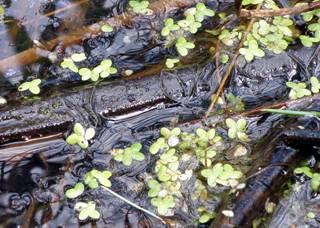As the kayak glides through the still water of a marshy bay it parts the green verdure floating on top. A bullfrog sits camouflaged amidst the tiny leaves. This is no algae bloom. Each spot of green is a separate little plant, the smallest of the rooted plants. Duckweed.
Due to their small size, duckweeds are often confused with algae. Like algae they can proliferate and cover stagnant regions of nutrient rich water. Quiet backwater bays, stormwater ponds, farm ponds, and slow-moving lowland streams can be filled with the plants. If the water is not stagnant, duckweeds simply blow away and the population never builds up. So, unlike algae blooms, which can appear anywhere on the lake, duckweeds’ range is more restricted.
Duckweeds consist of little more than a leaf-like frond with perhaps a few roots at the bottom. The frond is not a true leaf because they contain buds within them that can produce more fronds. True leaves would not be able to sprout more leaves. Most reproduction in duckweeds is by vegetative budding. Only rarely do they produce flowers, which consist of two stamens (male-parts) and a single style (female part). Species differ as to when they flower. In some, flowering is triggered by long days, while in others short days serve as a trigger.
Duckweeds produce both seeds and vegetative overwintering structures known as turions.
Fruits range from 0.4 mm - 2mm in size. The one-seeded fruits of the genus Wolffia are undisputed as the smallest fruits of any known plant species. The seeds sink and are resistant to drying. These features help duckweed re-colonize quickly when shallow water bodies dry. The vegetative turions can lie dormant at the bottom of a water body. These too can sink but are no more resistant to drying than are the leaves of the plant. They are however resistant to frost.
In the northeast there are about ten different species of duckweed in four different genera (numbers vary depending on the taxonomist doing the counting). Genera differ based upon the number of roots (many, one, or none) and the shape of their frond. Smalller duckweed species are also called water-meal.
Some species produce up to 21 roots per frond. Most absorption of water and nutrients occurs through the leaf itself. Roots act principally as anchors to keep the plant right-side up and restrict its motion in a wind. Roots are also sticky and attach easily to birds, mammals, and hard surfaces such as my kayak. This aids the plant in dispersal.
Admittedly, more effort is expended to control duckweed than to understand it. Like algae, people see duckweeds as a nuisance to recreation, though the plants do not produce any toxins like some algae or sharp seeds like water chestnuts. But the plant does have its charms. Like puppies or kittens the very size of these diminutive plants makes them attractive, at least in isolation. Since they are easy to grow, duckweed has been the subject of numerous school lab experiments. Many students get their first introduction to a microscope by looking at the air filled cells of duckweed that help the plant float. And people are always looking for ways to put the plant to use.
The United Nations Food and Agriculture Organization published a booklet promoting aquaculture of duckweed. They claim duckweed can be harvested as a food source for livestock or as one component in a series of treatments for human or animal wastes in third world countries. Duckweed does seem to have relatively high protein content. The booklet notes, “Duckweeds have been largely researched as a total feed for fish, including carp and tilapia production, as a protein supplement for pigs and poultry (including ducks) and as a fermentable N (nitrogen) and mineral supplement for ruminants.” They even note that duckweed has been eaten by humans and it “makes a fine addition to a salad and is quite tasty.” However, since duckweed does accumulate any excess minerals in the water “it is necessary to be cautious in recommending wide scale application.”
Duckweed has also been considered for use in treating human or animal wastes. Such systems are most appropriate when temperatures do not drop below 450 F, so seasonal or indoor treatment (at farms for example) would be necessary in our climate. Researchers calculated that 10 acres of shallow duckweed-covered lagoons could treat the waste from 100 cows while harvests from the lagoon could provide 60% of the daily protein requirements of the cows (assuming they would eat it).
Some scientists from North Carolina State University have speculated that duckweed could be used as a bio-fuel. They found they could produce five to six times more starch per acre with duckweed than with corn. At the same time, they were using the duckweed to remediate impacts of hog manure on water quality.
Duckweed will always be a part of any quiet water ecosystem. It is a food source for fish and, as per its name, ducks, and it is worthy of attention in its own right. There is more hidden in a patch of duckweed than just the frogs.
